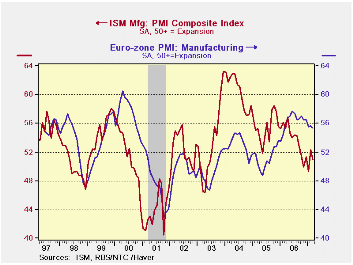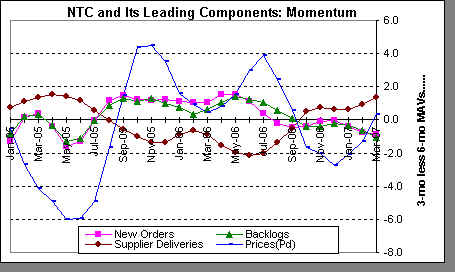 Global| Apr 02 2007
Global| Apr 02 2007A rose is a rose is a rose (Existentialism) Arroz es arroz es arroz (Rice is rice) MFG is MFG is MFG (The law of [...]
 As you can tell from the chart on the left the sense of there being separate business cycles in the US and in Europe is a sort of joke. The US and Euro area manufacturing indexes are plotted on top of one another and their sense of co-variation is unmistakable. Also the US is shown to be the male and E-zone is the female; that is to say, if we regard this as a dance, the US leads.
As you can tell from the chart on the left the sense of there being separate business cycles in the US and in Europe is a sort of joke. The US and Euro area manufacturing indexes are plotted on top of one another and their sense of co-variation is unmistakable. Also the US is shown to be the male and E-zone is the female; that is to say, if we regard this as a dance, the US leads. In the recent mini-cycle, Europe has struck out a bit on its own. A US up-cycle from mid-2005 aborted early, turning to decline. Meanwhile, Europe has continued to expand and only recently has hit a plateau with hint of erosion. In the US, the down-cycle is only showing early signs of stabilization. We wonder if Europe needs the US more than the US needs Europe?
The table above shows hath the E-zone readings, while off peak, are still very high in the range they have occupied since Mid-1997. The overall index is in the top 30% of its range and stands 6% above its average. Orders are similarly strong. Supplier deliveries are showing the weakest relative performance 10% below their average of the period.
| Since June'98 | |||||||||
| NTC E-zone | Current | Std Dev | Average | SD% Avg | MAX | MIN | Range | Percentile | % of AVG |
| NTC Index | 55.4 | 3.8 | 52.5 | 7.3 | 60.5 | 42.9 | 17.5 | 71.1 | 106 |
| New Orders | 56.4 | 4.6 | 53.5 | 8.7 | 62.4 | 41.0 | 21.4 | 72.3 | 105 |
| Backlogs | 53.9 | 3.1 | 52.0 | 5.9 | 57.6 | 47.2 | 10.5 | 64.1 | 104 |
| Production | 57.4 | 4.2 | 54.2 | 7.7 | 62.8 | 43.0 | 19.9 | 72.8 | 106 |
| Supplier Deliveries | 42.5 | 4.8 | 47.2 | 10.1 | 56.9 | 34.7 | 22.2 | 35.1 | 90 |
| Inventories | 48.7 | 1.0 | 48.3 | 2.0 | 50.4 | 46.2 | 4.3 | 58.9 | 101 |
| Prices (Pd) | 66.1 | 9.8 | 59.7 | 16.4 | 76.5 | 37.7 | 38.8 | 73.3 | 111 |
| Employment | 52.9 | 2.9 | 49.8 | 5.8 | 56.0 | 44.2 | 11.8 | 73.9 | 106 |
| New Export Orders | 55.3 | 4.3 | 52.8 | 8.1 | 60.0 | 39.4 | 20.6 | 77.5 | 105 |
| Note: From June 1997 to Date; except back logs since Nov '02 | |||||||||
 The leading components of the NTC E-zone index are showing mixed trends. We form these trends as the difference between the 3 month and six month indexes. Supplier deliveries and prices-paid are turning up while new orders and order backlog trends are eroding.
The leading components of the NTC E-zone index are showing mixed trends. We form these trends as the difference between the 3 month and six month indexes. Supplier deliveries and prices-paid are turning up while new orders and order backlog trends are eroding.
On balance, we can see the strong US-Europe linkages or commonalities. The history looks as though the US cycle gets transmitted to Europe, but Europe is recently showing some independent strength. However, it is also showing some sign of decay. It hardly seems as though a further rise in the Euro can do any good for Europe. But, so far so good.
Robert Brusca
AuthorMore in Author Profile »Robert A. Brusca is Chief Economist of Fact and Opinion Economics, a consulting firm he founded in Manhattan. He has been an economist on Wall Street for over 25 years. He has visited central banking and large institutional clients in over 30 countries in his career as an economist. Mr. Brusca was a Divisional Research Chief at the Federal Reserve Bank of NY (Chief of the International Financial markets Division), a Fed Watcher at Irving Trust and Chief Economist at Nikko Securities International. He is widely quoted and appears in various media. Mr. Brusca holds an MA and Ph.D. in economics from Michigan State University and a BA in Economics from the University of Michigan. His research pursues his strong interests in non aligned policy economics as well as international economics. FAO Economics’ research targets investors to assist them in making better investment decisions in stocks, bonds and in a variety of international assets. The company does not manage money and has no conflicts in giving economic advice.






